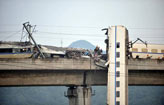Op-Ed Contributors
Debate: High-speed trains
Updated: 2011-07-29 07:49
(China Daily)
Should China halt or slow down the expansion of its bullet train network after the July 23 accident in Wenzhou, Zhejiang province? China Daily brings three diverse views on the subject.
Tragedy exposes railway system flaws
Hexie is the Chinese word for harmony. It was also the name of the Chinese high-speed train that crashed into another bullet train on July 23, an accident deadly enough to make the name sound like an empty slogan.
The tragedy turned the long-held fear that China's fast-expanding rail network is vulnerable to major disasters into reality.
Specialists have said that China's automatic high-speed train control system may not have been functioning properly at the time of the accident. The disaster is certain to deal a heavy blow to China as it seeks to export the bullet train system overseas, including to the United States. Over the years, China has strived to develop the system, which it hopes will boost its national pride.
Just more than four years have passed since China introduced high-speed trains. The country's rapidly growing railway network has expanded by leaps and bounds during that time, with high-speed trains running over more than 8,000 kilometers today - several times more extensive than Japan's Shinkansen network. China hopes to extend the network to 18,000 km by the end of 2020.
But it seems China's success in high-speed rail is the result of crash construction work intended to add an extra touch of glory. There is no denying that the rushed work has been made possible by slighting the safety of the high-speed railway system.
China's 10-trillion-yuan ($1.55 trillion) bullet train network project has been fraught with corruption. In February, Liu Zhijun was sacked as railways minister and arrested on suspicion of accepting huge sums as bribes from corporations tied to the project over the years.
While in office, Liu issued a directive that bullet trains should run along the Beijing-Shanghai route at 350 km an hour, hoping to make China's high-speed railway the world's fastest. His successor rescinded the policy and decided to set the maximum speed at 300 km an hour for safety reasons.
Passengers traveling on China's high-speed trains include expatriates, tourists and businesspeople from overseas. The seriousness of the July 23 accident must be taken to heart by the Chinese government. Beijing must conduct a thorough investigation into all aspects of its bullet train network, from its rolling stock to its operational routines.
China has said the trains operated on the Beijing-Shanghai route were modeled on the Tohoku Shinkansen's Hayate, a bullet train built by Kawasaki Heavy Industries, but has insisted that they were developed into a new creation through China's home-grown technology. Beijing has even applied for a global patent on its bullet train.
But the July 23 accident is bound to harm China's bullet train export drive.
The Yomiuri Shimbun/Asia News Network

Specials

Wen pledges 'open' probe
Design flaws in the signal equipment led to Saturday's fatal high-speed train collision, authorities say.

Turning up the heat
Traditional Chinese medicine using moxa, or mugwort herb, is once again becoming fashionable

Ciao, Yao
Yao Ming announced his retirement from basketball, staging an emotional end to a glorious career.